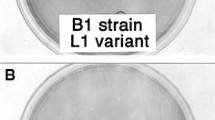Conclusions
-
1.
There is a linear relationship between the log dose of Junin virus inoculated in guinea pigs and the mean reciprocal time of death.
-
2.
The decrease of infectivity is not significant when the virus is kept for 26 hours at 25° C or six hours at 37° C; but the inactivation is practically complete after 192 hours at 4° C, 72 hours at 25° C, 26 hours at 37° C or 10 minutes at 56° C.
-
3.
The infectivity does not change between pH 6.5 and 9.5 after six hours at 4° C or between pH 6.5 and 9.0 after 18 hours. The inactivation was less than one logarithmic unit after 6 hours and 18 hours at pH 5.5 but was practically complete at pH 4.5 or lower after six hours.
-
4.
Junin virus was very sensitive to ultraviolet radiation. The infectivity decreased significantly after five seconds of exposure at 67 cm. from the ultraviolet lamp and it was practically complete after 30 seconds of irradiation.
-
5.
Junin virus is completely sedimented in 4 hours at 107,000 g. Assuming spherical form and 1.2 g/cc. density of the solvated particle, the diameter of the virus particle was estimated at 18–25 mμ.
-
6.
Chemical analysis of partially purified preparations showed that Junin virus contains ribose nucleic acid.
Similar content being viewed by others
References
Parodi, A. S.: Dia. méd.62, 2300 (1958).
Boxaca, M., andA. S. Parodi: Rev. Soc. argent. Biol. 37–170 (1961).
Albaum, H. G., andUmbreit: J. biol. Chem.167, 369 (1947).
Seibert, F.: J. biol. Chem.133, 593 (1940).
Dische, Z.: Proc. Soc. exp. Biol. (N. Y.)55, 217 (1944).
Gard, S.: J. exp. Med.72, 69–77 (1940).
Golub, O. J.: J. Immunol.59, 71–82 (1948).
Bauer, D. J.: Brit. J. exp. Biol.41, 130–139 (1960).
León, M., Riley, C. Williams, Patrick, andW. Campbell, Jr.: J. Bact.85, 1256–1260 (1963).
Melnick, J. L.: J. infect. Dis.79, 27 (1964).
Gresikova-Kohútová: Acta virol.3, 215 (1959).
Anderson, S. G., andG. Ada: Aust. J. exp. Biol. med. Sci.37, 353 (1959).
Olitsky, P.K., andD. H. Clarke: Arthropod-borne group B virus infections of man. In ”Viral and Rickettsial Infections of Man” ed. River T. M. and I. L. Horsfall, Jr., p. 305. J. B. Lippincot Co. Philadelphia-Montreal (1959).
Lépine, P.: C. R. Soc. Biol. (Paris)27, 476 (1931).
Duffy, C. E., andW. M. Stanley: J. exp. Med.82, 385 (1945).
Pollard, E. C.: The physics of viruses. Academic press (1953).
Pickels, E.: J. gen. Physiol.26, 341–360 (1943).
Author information
Authors and Affiliations
Additional information
This research was supported by a Grant E-4753 of N.I.H.—U.S.A.
Research Fellow of the Consejo National de Investigaciones Científicas y Técnicas de la República Argentina.
Rights and permissions
About this article
Cite this article
Parodi, A.S., Coto, C.E., Boxaca, M. et al. Characteristics of Junin Virus. Archiv f Virusforschung 19, 393–402 (1966). https://doi.org/10.1007/BF01250608
Received:
Issue Date:
DOI: https://doi.org/10.1007/BF01250608




